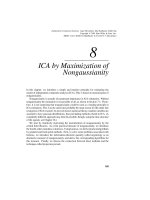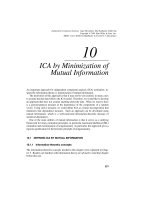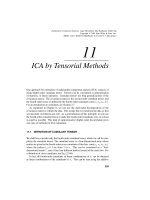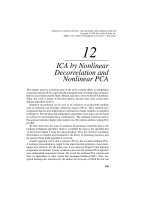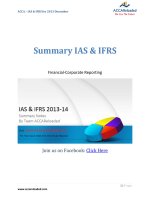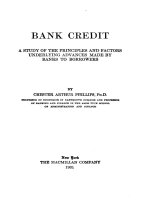Ichimoku beginner by gabor kovacs
Bạn đang xem bản rút gọn của tài liệu. Xem và tải ngay bản đầy đủ của tài liệu tại đây (2.82 MB, 64 trang )
Ichimoku World Book Series
Volume One
Ichimoku Beginner
Gabor Kovacs
2010
2
Copyright © 2010 by Gabor Kovacs. All rights reserved.
First published in December 2010 by Gabor Kovacs.
No part of this book may be reproduced or transmitted in
any form or by any means, electronic or mechanical,
including photocopying, recording or by any information
storage and retrieval system, without prior permission in
writing from the publisher. However you can share
this book anytime with anyone for free.
Limit of Liability/Disclaimer of Warranty
While the author has used his best efforts in preparing
this book, he makes no representations or warranties
with respect to the accuracy or completeness of the
contents of this book and specifically disclaim any
implied warranties of merchantability or fitness for a
particular purpose.
This information has been prepared to provide general
information only. It is not intended to take the place of
professional advice and you should not take action on
specific issues in reliance on this information. In
preparing this information, we did not take into account
the investment objectives, financial situation or
particular needs of any particular person.
Before making an investment decision, you need to
consider (with or without the assistance of an adviser)
whether this information is appropriate to your needs,
objectives and circumstances.
3
I dedicate this book to Angelika,
without whose assistance, advice and support
this book wouldn't be possible.
4
CONTENTS
INTRODUCTION
PART ONE
PART TWO
6
GETTING TO KNOW THE ICHIMOKU METHOD
7
What is Ichimoku Kinko Hyo
8
Setting up the charts
13
BASIC CHART ANALYSIS
16
Using Ichimoku as a charting system
17
Using Ichimoku as a trading system
28
Example analyses
36
PRACTICE
46
Answer Key
59
Creating your first basic Ichimoku analysis
PART THREE
FINAL WORDS
Exercieses
33
47
64
5
Introduction
The Ichimoku World Book Series is a series of three books,
each written at the right level for you at each stage in your
study of the Ichimoku Kinko Hyo system.
The Ichimoku Beginner was written especially for those, who
are completely new to the Ichimoku method. The book is
devided into three main parts, each of which covers an
important topic of basic Ichimoku trading.
The Getting to Know the Ichimoku Method chapter
introduces the Ichimoku Kinko Hyo system. Also it helps to
set up the charts with the Ichimoku indicator, and explains
the components of the system.
The Basic Chart Analysis chapter teaches how to create a
basic chart analysis with Ichimoku, shows how to use it as a
charting system and explains how to find exact entry
opportunities with the help of it.
The Practice section at the end of the book gives the
opportunity for practice and enable you to assess how much
you have learned. Answers to the exercises are given at the
back of the book.
To find more analyses, explanations, learning materials and
videos in connecting with the way I trade the Ichimoku
system, please visit the Ichimoku World website at
Have a great time reading this book!
Gabor Kovacs
6
Part One
Getting to Know the Ichimoku
Method
7
What is Ichimoku
Kinko Hyo?
Ichimoku Kinko Hyo is a multifunctional visual trend
following charting system. It mentioned to be the king of the
indicators and trading or analyzing with it is a kind of highlevel art.
What does it's name
mean?
Ichimoku means: one glance, Kinko means: equilibrium (or
balance), and Hyo means: chart. The term Ichimoku Kinko
Hyo could be translated as: 'One glance equilibrium chart',
or 'Chart balance at a glance'.
8
Who created the
Ichimoku Kinko Hyo
system?
It was developed by a Japanese economic journalist, name
Goichi Hosoda, who aimed to create a kind of „all-in-one”
indicator to analyze the charts more deeply but in less time.
The development of the system was a huge and complex
work, as there was no possibility for doing automated back
tests at that time. Goichi Hosoda started the process before
the Second World War, with a large group of hired students,
who had to manually backtest the different calculated
formulas. Finally, after more then twenty years of testing and
chiseling, Hosoda presented the Ichimoku Kinko Hyo
charting system in his book in 1969, and it rapidly became
the most frequently used indicator in Japanese trading
rooms.
Why is the system so
special?
With Ichimoku, it is possible to get the whole picture of the
market,
including
trend
direction,
the
main
support/resistance levels, and exact entry or exit points. It
also helps to define the strength of the signal. It is also
important, that Ichimoku can be used successfully for all
markets and on all time frames, but – like most indicators it performs a bit better on the higher ones.
9
Is it possible to read
the original book of
Goichi
Hosoda
in
English?
Unfortunatelly no, as the original Ichimoku books and
materials have never been translated into English. Many
believes, that these materials are currently stored in a secret
safe of the Bank of Japan. Also, it is a gossip, that the whole
method described in Hosoda's book was never been shared
fully with the public, and there might could be a secret bonus
component of the system. However these gossips were never
confirmed officially.
10
Is it a stand-alone
system?
Ichimoku Kinko Hyo can be used in many ways. It can be
used as a stand-alone system, or it can be used as a trend and
price behaviour analyser and can be combined with any
trading systems or strategies. It also can be used as an entry
signal generator, or it can be used to filter the signals of
another trading system. Furthermore, as trading Ichimoku is
a kind of high-level art, and art is quite a subjective thing,
every Ichimoku trader trades the Ichimoku a bit differently.
Ichimoku with a commercial trading system.
Ichimoku with another Japanese system, the Renko.
11
What official sources
use Ichimoku regularly
for chart analysis?
Just to mention a few from the bigger news sources:
12
How can I add the
Ichimoku indicator to
my MT4 charts?
1. Download and install the free Metatrader4 (MT4)
platform. You can choose any broker that supports
Metatrader4 such as Alpari, InterbankFX, FXDD, FXPro etc.
Feel free to use your existing brokerage account or choose
one by yourself.
2. Open your Metatrader4.
3. On the Navigator panel of your Metatrader choose
Indicators> Ichimoku, and add it to you chart(s).
What are the standard
settings of Ichimoku
and why?
The standard settings of are: 9-26-52. The base number of
the formula is 26. The common view is that the number 26
represents a standard Japanese business month (which
13
included Saturdays), the number 9 represents a week and a
half and the number 52 represents two months. Some hold
different views and says that the calculation of Goichi
Hosoda based on - among others - Moon cycles, as the
number 26 is the best approximate number to express a full
Moon cycle, the number 9 represents one and a half quarter
Moon cycle, and number 52 represents a double Moon cycle.
Is it possible to use
alternative
setting
values?
Yes, it is possible. Some traders use the values of 2-22-44,
however the recommended settings are still the original
values.
What
are
components
the
of
the
Ichimoku Kinko Hyo
system?
Ichimoku Kinko Hyo is constituted by five lines:
- The Tenkan-Sen (Conversion line) is calculated as
(Highest High + Lowest Low)/2 for the past 9 periods.
- The Kijun-Sen (Standard line) is calculated as (Highest
High + Lowest Low)/2 for the past 26 periods.
- The Chikou Span (Lagging Span) is calculated as current
price time-shifted backwards 26 periods.
- The Senkou Span A (Faster Span A) is calculated as
(Tenkan-Sen + Kijun-Sen)/2.
- The Senkou Span B (Faster Span B) is calculated as
(Highest High + Lowest Low)/2.
14
Is it necessary to learn
the Japanese name of
the elements?
It is very important to learn the exact Japanese name of the
Ichimoku lines, also it is a must to be able to identitfy the
lines at a galnce when they are on a chart.
Please read the following chapters only, if you have fully
understood and mastered the informations of this chapter. If
you have to think about which line is which, please continue
practicing the terminology and the identification of the lines
before continuing to the next chapters.
15
Part Two
Basic Chart Analysis
16
Using Ichimoku as a
charting system
When we use the Ichimoku Kinko Hyo system as a charting
system, we don't want to get entry or exit signals, but we
want to get important informations about the market, for
example the trend direction, the future possibilities and the
main support and resistance levels.
Identifying the trend
„Trend is your friend” - this is one of the basic and widely
known
concepts
of the technical analysis.
However
unfortunately it is not just that easy. Trends spectacularly
stand out on historical charts, but identifying a trend in the
beginning of it is one of the hardest tasks in chart analysis.
This following few paragraphs will show how trends can be
spotted out with Ichimoku Kinko Hyo.
Analyzing the Kumo
The latter two lines – Senkou Span A and Senkou Span B –
form the unique Kumo feature of the system. To indentify
the trend, the first thing is to observe this component on it's
own and versus the other components and the price.
a) The color of the Kumo
If Senkou Span A is above Senkou Span B, the color of the
Kumo is light and it indicates a possible bullish trend. If the
Senkou Span A is below Senkou Span B, the Kumo color is
dark and the trend is indicated as bearish. When Senkou
Span A crosses Senkou Span B the color of the Kumo
changes, and it raises the plausibility of a possible trend
change.
17
b) The thickness of the Kumo
The thicker the Kumo, the stronger the trend is. A significant
Kumo means strong trend and a tiny Kumo indicates a weak
trend, as it is more easy for the price to move through a thin
Cloud than a thick one. However it is important to keep in
mind, that the top and the bottom of the Kumo mean
support and resistance lines, so even a thin Kumo can turn
the price back to it's previous direction, however the chances
are lower.
18
c) The Kumo versus price
One of the most basic fundamentals of Ichimoku is: if the
price is above the Kumo, the trend is bullish, and if the price
is below the Kumo, the trend is bearish. It is very visible and
easy to determinate if the overall trend is bullish or bearish
with this method. It follows that every trend begins with a
Kumo breakout, when price breaks out from the Kumo cloud
on the upside or on the downside, however for a perfectly
formed Kumo breakout Chikou Span has to break out from
the Kumo too to confirm the direction. When price is moving
in the body of the Cloud, it shows suspense in the trend.
d) The Kumo versus Chikou Span
Chikou Span can be above the Kumo (bullish trend), below
the Kumo (bearish trend) or in the Kumo (neutral,
undecided trend). Chikou Span is a very important trend
19
confirmation tool, so it is necessary to always reckon with
the chart analysis.
e) The Kumo versus Kijun-Sen and Tenkan-Sen
However the position of Kijun-Sen and Tenkan-Sen is
usually compared to the price, it's place versus the Kumo can
be the indicator of the strength of the trend too. If these lines
are extruding on the upside of the Kumo, it supports further
bullish trend. The opposite of it supports the continuation of
the bearish trend.
20
Comparing
components
the
other
versus
price
We have already compared the Kumo versus price. Now let's
do the same with the other components of Ichimoku.
a) Chikou Span versus price
If the Chikou Span crosses up the price it can be counted as a
bullish sign, and vice versa. If the price is on the upside of
the Kumo and Chikou Span crosses it up, it is a very strong
sign of the possibility of a longterm uptrend, and the
opposite of it indicates a strong downtrend. If Chikou Span
is in the Kumo, the trend is undecided, because the Senkou
Span A and Senkou Span B support and resistance lines can
affect to it strongly, and Chikou Span can bounce the price
back even it has already broken out from the body of the
Cloud.
21
b) Kijun-Sen versus price
The Kijun-Sen is behaving as a a very strong support or
resistance level so it is a very important tool of identifying
trend changes. If price crosses it up, this is a bullish sign, if
price crosses it down, that is a bearish sign. A bullish cross
can happen above the Kumo (strong sign), in the Kumo
(neutral sign), or below the Kumo (weak sign), and vice
versa. The distance between Price and Kijun-Sen can be very
telling too, as if price leaves behind Kijun-Sen far away, it
usually turns flat and attracts back the price to create
equilibrium. Please notice, that this is not a sign of the trend
change, but only a bounce, and after the harmony of the
Kijun-Sen and price was restored, they usually move in the
direction of the trend again.
22
c) Tenkan-Sen versus price
Tenkan-Sen is more sensitive to minor price movements, as
it represents the momentum, however it can be used as a
trend-confirmation tool too. For example if price is in a
trend, it usually creates waves, and moves back through
Tenkan-Sen to Kijun-Sen, then bounces into the direction of
the trend again. If price moves through Tenkan-Sen in the
direction of the trend in the course of a bounce, it confirms
the continuation of the trend.
d) Chikou Span versus Kijun-Sen
Chikou Span can be above (bullish sign), or below (bearish
sign)
Kijun-Sen.
As
Kijun-Sen
is
a
very
strong
support/resistance level, as long as the Chikou Span is above
it the bullish movements are well supported, and if Chikou
Span is staying below Kijun-Sen, the down movements are
supported. It is very common, that Chikou Span is bouncing
on the Kijun-Sen before a huge move happens.
23
e) Tenkan-Sen versus Kijun-Sen
A Tenkan-Sen/ Kijun-Sen cross can also indicate the change
or the continuation of the trend. An up cross can happen
above the Kumo (strong signal), in the body of the Kumo
(neutral signal), or below the Kumo (weak signal) and vice
versa.
24
The
picture
of
the
ideal trend
However the components of the Ichimoku Kinko Hyo system
were described separately, it is indispensable to use both
components together to see the overall trend and the whole
picture at a glance.
It follows that the description of an ideal bullish trend sign
or confirmation would be:
1. the price is above the Kumo, Tenkan-Sen and Kijun-Sen
2. the Kumo is thick and bullish
3. the Tenkan-Sen has crossed up Kijun-Sen above the
Kumo
4. the Chikou Span is above both Kumo, Tenkan-Sen,
Kijun-Sen and price
The picture of an ideal bearish trend would be:
1. the price is below the Kumo, Tenkan-Sen and Kijun-Sen
2. the Kumo is thick and bearish
3. the Tenkan-Sen has crossed down Kijun-Sen below the
Kumo
4. the Chikou Span is below both Kumo, Tenkan-Sen,
Kijun-Sen and price
25

